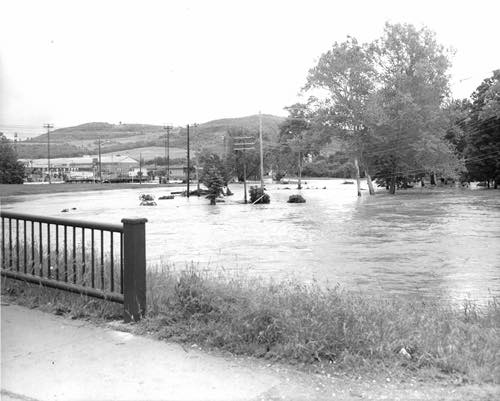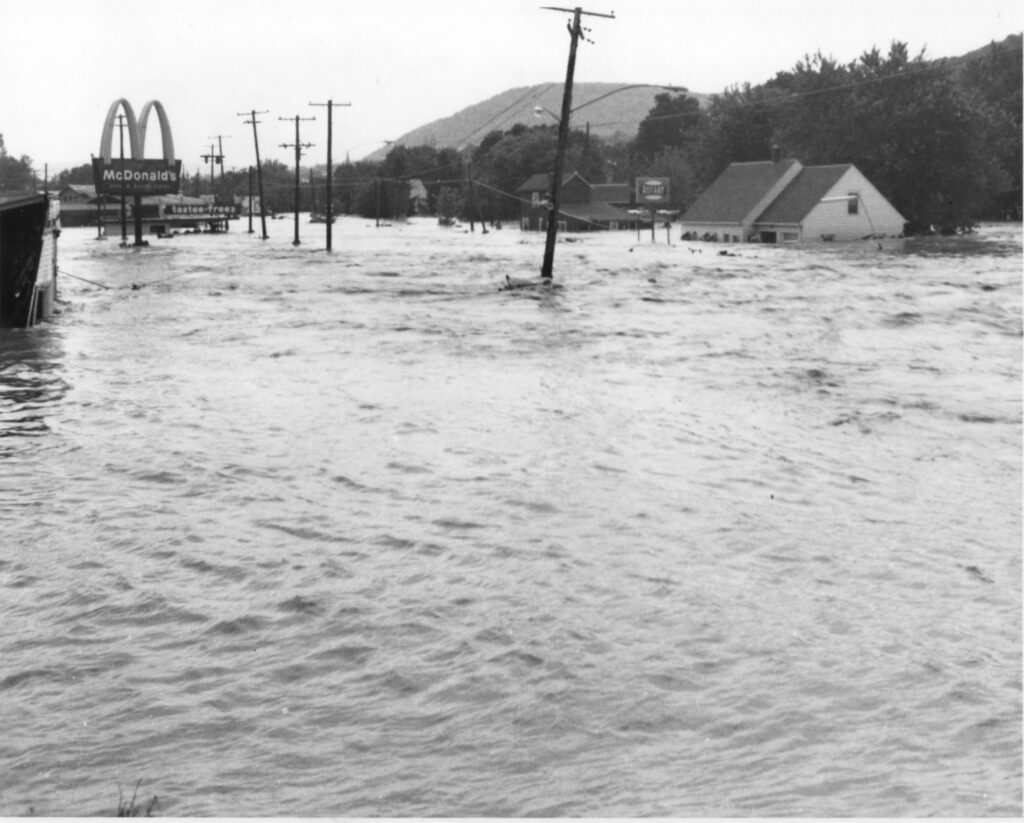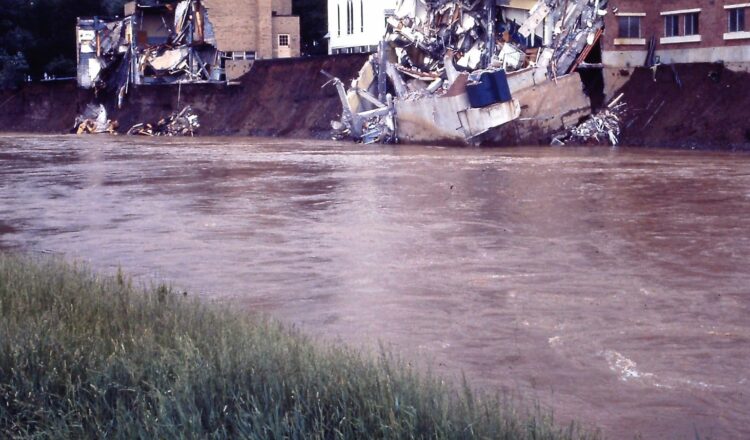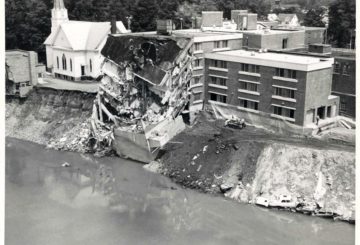Lonsberry recalls the devastation brought by Hurricane Agnes
Photo from Wellsville NY Historical Society
Before the sun was fully up, there was a pounding on the front window of the trailer and a man’s voice.
“Ahoy, Pebbleses,” it said. It was Ted Woehr, my teacher’s husband. I was in the sixth-grade and this was to have been the last day of school. He was standing in a flatboat. “You’ve got to get out.”
It had been raining all night. Raining like I’d never seen before. Agnes had come up the eastern seaboard and parked over the drainage of the Susquehanna and Bennetts Creek across the road wasn’t across the road anymore. We had watched it in the pre-dawn come out of its banks and cross Route 36 and move across the flat to our trailer.
It was a 12-by-65 Marlette that I had picked out with the insurance money two years before, after my step-father died at the breakfast table one Saturday morning in California. I went with the man from church to pick out the casket and I went with my grandmother to pick out the trailer and it had been trucked in between where the barn and the chicken house had stood on the old farm where my grandmother raised her seven kids, back east, in Canisteo, in the Southern Tier of New York.

Across the road from Bennetts Creek, which 50 years ago today was merging with the Canisteo River and Colonel Bill’s Creek to form a broad swirling lake rising above the flats where Mr. VanWie grew his corn and the Yoders kept their horses. It was an urgent and anxious mass of water filling the valley like a tub, the southward drain of the river toward Adrian and Corning and ultimately Baltimore overwhelmed by the inflow and backing up the flotsam of trees and trash and shattered buildings into our homes and lives.
My grandmother’s house by the road, which had stood the floods of 150 years, was up to the sills and already pushed from its foundation, no one ever to spend another night in it. Two months before in the living room there my mother had married a man who lived across the fence in Harley Zeller’s trailer park, and it was he who yelled back to Mr. Woehr that there were nine of us in the trailer and that we could get ourselves into town.
My mother was 31 then, with four kids and a husband, for six of us. Plus my grandmother who had walked across the field and up the hill to our trailer in the night, after everything of value in her house had been carried to the second floor. And Basil Stiles and his wife, also newlyweds, I think, who lived across the creek next to the Silver Bridge, who had been flooded out early.
It was the nine of us, and Ted Woehr had been sent out with other volunteers from the fire department to tell everyone on the Willow Bend Road and beyond to escape to the hills or come into the village behind the dikes. They were a skirt of earthworks around the southern and eastern flanks of the village, put up after the Flood of ’35, to keep the creek and the river from returning in the worst of circumstances to their ancient confluence in what had since become the center of the old Indian village of Canisteo.
The rain still fell in sheets and the crest was a good day away and the issue of evacuation was urgent. So while my mother and grandmother and Mrs. Stiles gathered children and clothes, Basil and my mother’s husband and I went out to move the cars farther up the hill, in hopes of keeping them above the water.
It was at my knees when we came down the steps. It was brown and smelled and things bumped against you, it swirled around everything and was heavy with the soil of the hills and valley. The Gremlin was light and as its tires spun we were able to push it backwards up the hill, to higher ground, out of the water and into the pasture. There was a second vehicle, a Volkswagen camper, the joy of my siblings’ father, paid off with his life insurance, but it was heavier and it mired quickly and as I pushed against its grill, the water now at my chest, I slipped and went under and washed with the current, coming to my feet some distance away, choking and spitting. We left it with the doors open in hopes that it wouldn’t be swept away and lost.

Then we left for the Silver Bridge and the dikes and the safety of the village.
It’s probably not even a quarter of a mile. But the rain was hard and the water was up and running and my mother and her husband and Basil and his wife had to get a first-grader, a preschooler, a babe in arms, a 12-year-old and an elderly, heavyset woman through. I can’t imagine their fear or courage, but they did it. We walked in a cluster along the side of the hill at the edge of the water, then waded across Harley Zeller’s property and came onto the submerged pavement of Route 36 in front of Dick Welles’ place.
That brought us to the Silver Bridge, which was green, and which no one now living remembers as silver or as being called anything other than the Silver Bridge. In the spring, you can see the suckers in their breeding runs in the water beneath, and in the summer, you can imagine its cool waters running decades ago to the big bend called B.A. – for “bare ass” – where the people in the cemetery once swam as kids.
That morning, the water surged and splashed onto the roadbed of the bridge, but it did not truly flow over it. As we walked across, soaked and shivering from fear and cold, we were not wading, but sometimes water did rush across our feet, and we did feel, in those brief moments, the shudder of the bridge against the force of the water and the debris it carried.
Crossing the Silver Bridge was a terror. You could see the creek, in all its raging torrent, and you could hear its thunder, and you could think of little other than the possibility of failure, or collapse, of death.
But it didn’t fail, it didn’t collapse, and within an hour we were taken in by Ray McChesney and his family, into their home on Depot Street, refugees from the flood. This is where we would sit out the storm and get back on our feet, where for three days straight we would listen to Kevin Doran on the radio, going without sleep, the only source of information and connection, as we heard about the deaths and the destruction and the path forward. I went to the hospital the second day, sickened by the water I’d ingested when I was submerged, riding through water out of town in a fire truck.
After that, what I remember most is my excitement at being at the McChesneys’, as I had a crush on their daughter Jane. And after that I remember the flood mud, and the summer of cleaning and shoveling that followed.
That was 50 years ago today.
We never got the smell out of our trailer, but we trucked it to the high ground of Obes Glen that fall and lived there, and my grandmother lived with an aunt until she got a little cracker-box house built way up the side of the hill, where no flood could ever reach.
For a long time, the Flood of ’72 was a milestone in time, a point of reference for people from two states. But time does what time does, and today few care and fewer remember, and lives march on.
But a long time ago, there was a flood. And I saw it. And this is how I remember it.

Bob Lonsberry, a Canisteo native, is the father of nine children, a veteran of the United States Army, and a newsman for nearly three decades. The former newspaper columnist, reporter, and author, is a marathon runner. You can hear Bob mornings on NewsRadio WHAM 1180 in Rochester and NewsRadio 570 WSYR and 106.9 FM in Syracuse. You can reach him at bob@lonsberry.com







